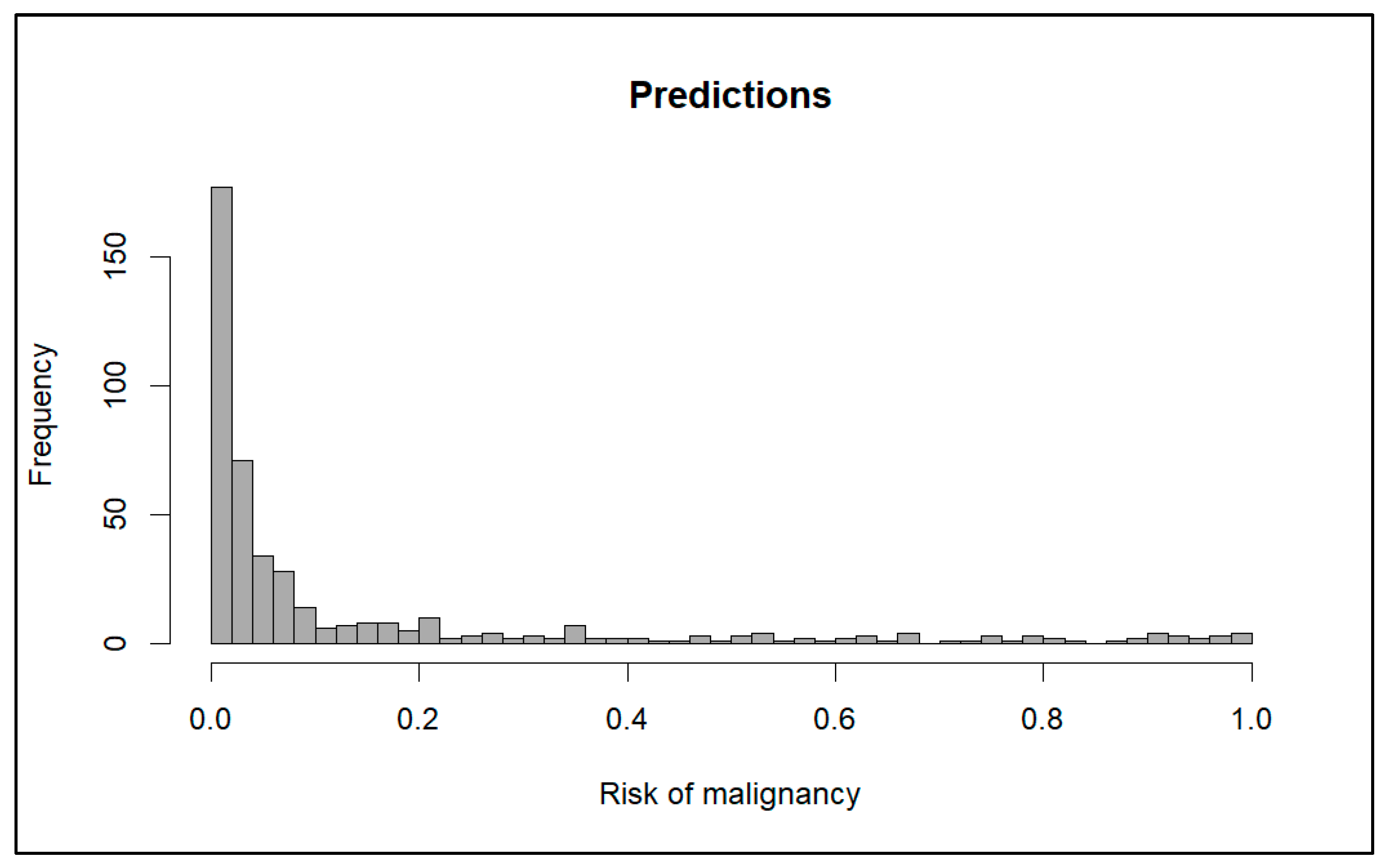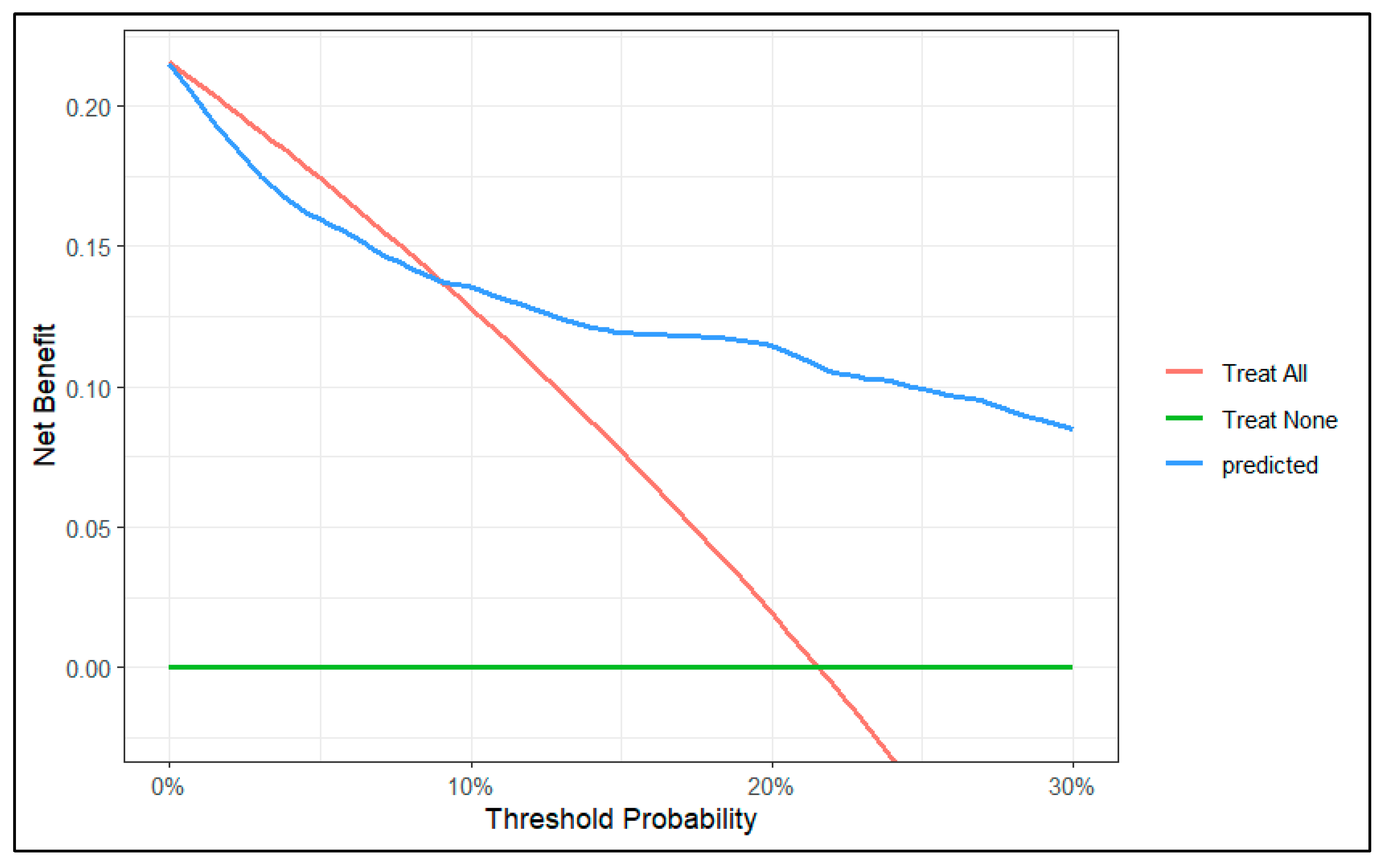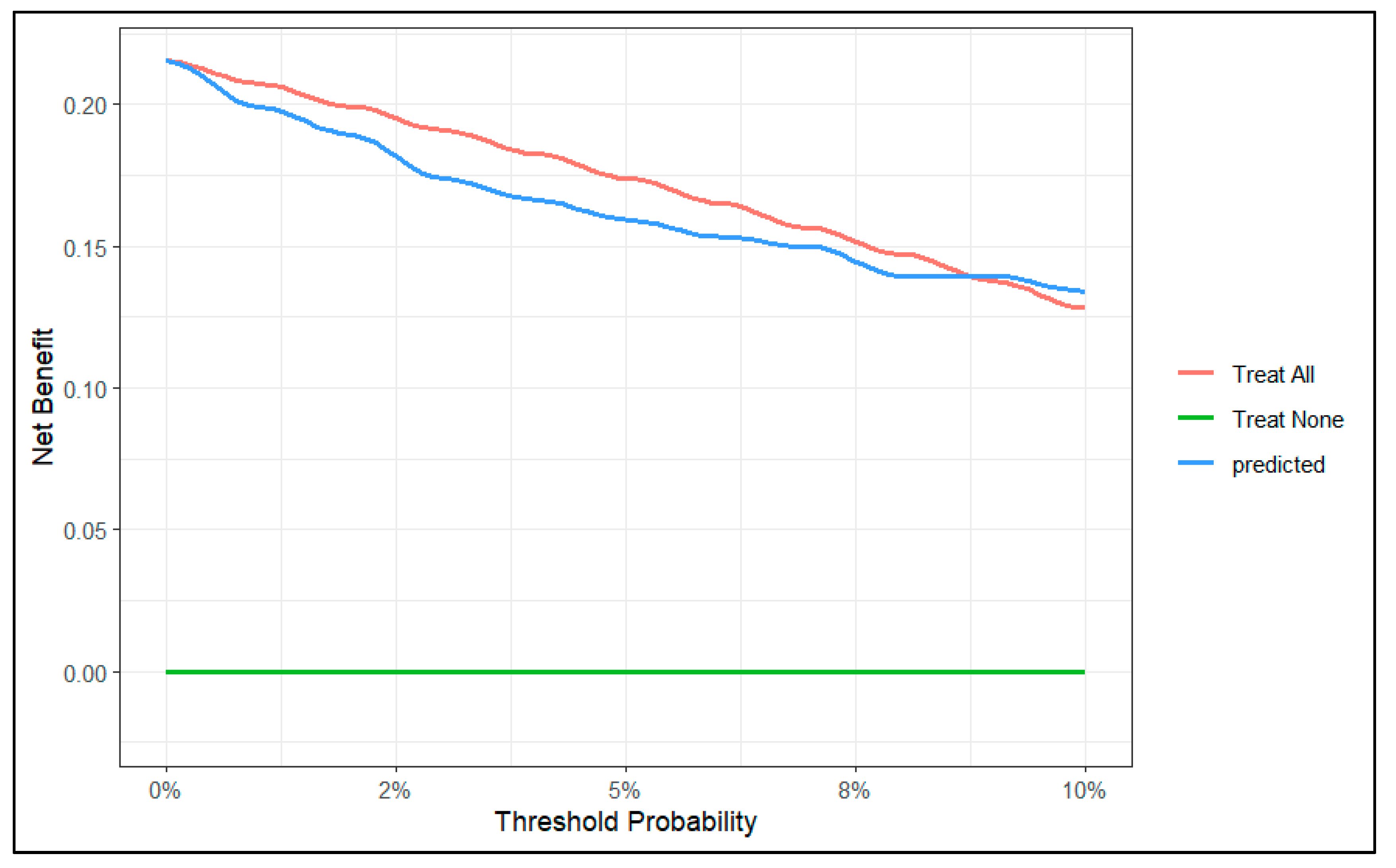External Validation of a Predictive Model for Thyroid Cancer Risk with Decision Curve Analysis
Abstract
1. Introduction
2. Materials and Methods
2.1. Patients
2.2. Statistical Analysis
3. Results
4. Discussion
5. Conclusions
Author Contributions
Funding
Institutional Review Board Statement
Informed Consent Statement
Data Availability Statement
Conflicts of Interest
Abbreviations
| PTC | Papillary Thyroid Carcinoma |
| AI | Artificial Intelligence |
| ML | Machine Learning |
| FNA | Fine-Needle Aspiration |
| ATA | American Thyroid Association |
| TC | Thyroid Cancer |
| IQR | Interquartile Range |
| SD | Standard Deviation |
| TSH | Thyroid-Stimulating Hormone |
| SE | Standard Error |
| OR | Odds Ratio |
| CI | Confidence Interval |
| TPOAb | Thyroid Peroxidase Antibodies |
| TgAb | Thyroglobulin Antibodies |
| US | Ultrasound |
| ROC | Receiver Operating Characteristic |
| AUC | Area Under the Curve |
| CART | Classification and Regression Trees |
References
- Kitahara, C.M.; Sosa, J.A. The changing incidence of thyroid cancer. Nat. Rev. Endocrinol. 2016, 12, 646–653. [Google Scholar] [CrossRef] [PubMed]
- Megwalu, U.; Moon, P. Thyroid Cancer Incidence and Mortality Trends in the United States: 2000–2018. Thyroid 2022, 32, 560–570. [Google Scholar] [CrossRef] [PubMed]
- Davies, L.; Morris, L.G.; Haymart, M.; Chen, A.Y.; Goldenberg, D.; Morris, J.; Ogilvie, J.B.; Terris, D.J.; Netterville, J.; Wong, R.J.; et al. American Association of Clinical Endocrinologists and American College of Endocrinology Disease State Clinical Review: The Increasing Incidence of Thyroid Cancer. Endocr. Pract. 2015, 21, 686–696. [Google Scholar] [CrossRef] [PubMed] [PubMed Central]
- Wiltshire, J.; Drake, T.; Uttley, L.; Balasubramanian, S. Systematic Review of Trends in the Incidence Rates of Thyroid Cancer. Thyroid 2016, 26, 1541–1552. [Google Scholar] [CrossRef] [PubMed] [PubMed Central]
- Vaccarella, S.; Maso, L.; Laversanne, M.; Bray, F.; Plummer, M.; Franceschi, S. The Impact of Diagnostic Changes on the Rise in Thyroid Cancer Incidence: A Population-Based Study in Selected High-Resource Countries. Thyroid 2015, 25, 1127–1136. [Google Scholar] [CrossRef]
- Miranda-Filho, A.; Lortet-Tieulent, J.; Bray, F.; Cao, B.; Franceschi, S.; Vaccarella, S.; Maso, L. Thyroid cancer incidence trends by histology in 25 countries: A population-based study. Lancet Diabetes Endocrinol. 2021, 9, 225–234. [Google Scholar] [CrossRef]
- Ruiz, G.; Carral, F.; Tinoco, R.; Ayala, C. El Aumento de la incidencia del cáncer diferenciado de tiroides no se relaciona con un incremento en la detección de microcarcinomas incidentales. Rev. Clin. Esp. 2016, 216, 292. [Google Scholar] [CrossRef]
- Gharib, M.H.; Afghani, R.; Rajaei, S.; Roshandel, G.; Alijani, A.; Karamollahi, Z.; Tatari, M.; Mohajernoei, S.; Hosseini, S.S.; Rezazadeh, S.A. Clinical Implication of the New AI-TIRADS Classification of Thyroid Nodules; Our Real Clinical Experience. Shiraz E Med. J. 2024, 25, e147642. [Google Scholar] [CrossRef]
- Sumayh, S.S.; Aljameel, A. Proactive Explainable Artificial Neural Network Model for the Early Diagnosis of Thyroid Cancer. De Computis 2022, 10, 183. [Google Scholar] [CrossRef]
- Li, W.; Hong, T.; Fang, J.; Liu, W.; Liu, Y.; He, C.; Li, X.; Xu, C.; Wang, B.; Chen, Y.; et al. Incorporation of a machine learning pathological diagnosis algorithm into the thyroid ultrasound imaging data improves the diagnosis risk of malignant thyroid nodules. Front. Oncol. 2022, 12, 968784. [Google Scholar] [CrossRef] [PubMed] [PubMed Central]
- Zhang, J.; Wang, Q.; Zhao, J.; Yu, H.; Wang, F.; Zhang, J. Automatic ultrasound diagnosis of thyroid nodules: A combination of deep learning and KWAK TI-RADS. Phys. Med. Biol. 2023, 68. [Google Scholar] [CrossRef] [PubMed]
- Mao, Z.; Ding, Y.; Wen, L.; Zhang, Y.; Wu, G.; You, Q.; Wu, J.; Luo, D.; Teng, L.; Wang, W. Combined fine-needle aspiration and selective intraoperative frozen section to optimize prediction of malignant thyroid nodules: A retrospective cohort study of more than 3000 patients. Front. Endocrinol. (Lausanne) 2023, 14, 1091200. [Google Scholar] [CrossRef] [PubMed] [PubMed Central]
- Carral San Laureano, R.F.; Fernández Alba, J.J.; Jiménez Heras, J.M.; Jiménez Millán, A.I.; Tomé Fernández-Ladreda, M.; Ayala Ortega, M.C. Development and Internal Validation of a Predictive Model for Individual Cancer Risk Assessment for Thyroid Nodules. Endocr. Pract. 2020, 26, 1077–1084. [Google Scholar] [CrossRef] [PubMed]
- Haugen, B.R.; Alexander, E.K.; Bible, K.C.; Doherty, G.M.; Mandel, S.J.; Nikiforov, Y.E.; Pacini, F.; Randolph, G.W.; Sawka, A.M.; Schlumberger, M.; et al. 2015 American Thyroid Association Management Guidelines for Adult Patients with Thyroid Nodules and Differentiated Thyroid Cancer: The American Thyroid Association Guidelines Task Force on Thyroid Nodules and Differentiated Thyroid Cancer. Thyroid 2016, 26, 1–133. [Google Scholar] [CrossRef] [PubMed] [PubMed Central]
- American Thyroid Association (ATA) Guidelines Taskforce on Thyroid Nodules and Differentiated Thyroid Cancer; Cooper, D.S.; Doherty, G.M.; Haugen, B.R.; Kloos, R.T.; Lee, S.L.; Mandel, S.J.; Mazzaferri, E.L.; McIver, B.; Pacini, F.; et al. Revised American Thyroid Association management guidelines for patients with thyroid nodules and differentiated thyroid cancer. Thyroid 2009, 19, 1167–1214, Erratum in: Thyroid 2010, 20, 942; Erratum in: Thyroid 2010, 20, 674–675. [Google Scholar] [PubMed]
- Carral, F.; Ayala, M.C.; Jiménez, A.I.; García, C. Care and economic impact of thyroid ultrasound examination at single visits to endocrinology clinics (the ETIEN 1 Study). Endocrinol. Nutr. 2016, 63, 64–69. [Google Scholar] [CrossRef]
- Carral, F.; Ayala, M.C.; Jiménez, A.I.; García, C.; Robles, M.I.; Porras, E.; Vega, V. Diagnostic performance of the American Thyroid Association Ultrasound Risk Assessment of Thyroid Nodules in Endocrinology (the ETIEN 3 study). Endocrinol. Nutr. 2020, 67, 130–136. [Google Scholar] [CrossRef]
- Riley, R.D.; Archer, L.; Snell, K.I.E.; Ensor, J.; Dhiman, P.; Martin, G.P.; Bonnett, L.J.; Collins, G.S. Evaluation of clinical prediction models (Part 2): How to undertake an external validation study. BMJ 2024, 384, e074820. [Google Scholar] [CrossRef] [PubMed] [PubMed Central]
- R Core Team. R: A Language and Environment for Statistical Computing; R Foundation for Statistical Computing: Vienna, Austria, 2024; Available online: https://www.R-project.org/ (accessed on 7 February 2025).
- Mangiafico, S.S. rcompanion: Functions to Support Extension Education Program Evaluation, Version 2.4.36; Rutgers Co-operative Extension: New Brunswick, NJ, USA, 2024. Available online: https://CRAN.R-project.org/package=rcompanion (accessed on 7 February 2025).
- De Cock Campo, B. Towards reliable predictive analytics: A generalized calibration framework. arXiv 2023. [Google Scholar] [CrossRef]
- De Cock, B.; Nieboer, D.; Van Calster, B.; Steyerberg, E.W.; Vergouwe, Y. The Calibrationcurves Package: Assessing the Agreement Between Observed Outcomes and Predictions. R Package Version 2.0.3. 2023. Available online: https://cran.r-project.org/package=CalibrationCurves (accessed on 7 February 2025).
- Van Calster, B.; Nieboer, D.; Vergouwe, Y.; De Cock, B.; Pencina, M.J.; Steyerberg, E.W. A Calibration hierarchy for risk models was defined: From utopia to empirical Data. J. Clin. Epidemiol. 2016, 74, 167–176. [Google Scholar] [CrossRef]
- Vickers, A.J.; Elkin, E.B. Decision curve analysis: A novel method for evaluating prediction models. Med. Decis. Making 2006, 26, 565–574. [Google Scholar] [CrossRef] [PubMed]
- Lubin, D.; Sadow, P.M. Development and validation of an RNA sequencing-based classifier for medullary thyroid carcinoma on thyroid FNA. Cancer Cytopathol. 2022, 131, 154–157. [Google Scholar] [CrossRef] [PubMed]
- Vrinceanu, D.; Dumitru, M.; Marinescu, A.; Serboiu, C.; Musat, G.; Radulescu, M.; Popa-Cherecheanu, M.; Ciornei, C.; Manole, F. Management of Giant Thyroid Tumors in Patients with Multiple Comorbidities in a Tertiary Head and Neck Surgery Center. Biomedicines 2024, 12, 2204. [Google Scholar] [CrossRef] [PubMed]
- Liu, F.; Han, F.; Lu, L.; Chen, Y.; Guo, Z.; Yao, J. Meta-analysis of prediction models for predicting lymph node metastasis in thyroid cancer. World J. Surg. Oncol. 2024, 22, 278. [Google Scholar] [CrossRef]
- Nixon, I.J.; Ganly, I.; Hann, L.E.; Yu, C.; Palmer, F.L.; Whitcher, M.M.; Shah, J.P.; Shaha, A.; Kattan, M.W.; Patel, S.G. Nomogram for selecting thyroid nodules for ultrasound-guided fine-needle aspiration biopsy based on a quantification of risk of malignancy. Head Neck 2013, 35, 1022–1025. [Google Scholar] [CrossRef] [PubMed]
- Ianni, F.; Campanella, P.; Rota, C.A.; Prete, A.; Castellino, L.; Pontecorvi, A.; Corsello, S.M. A Meta-analysis-derived proposal for a clinical, ultrasonographic, and cytological scoring system to evaluate thyroid nodules: The “CUT” score. Endocrine 2016, 52, 313–321. [Google Scholar] [CrossRef] [PubMed]
- Li, T.; Sheng, J.; Li, W.; Zhang, X.; Yu, H.; Chen, X.; Zhang, J.; Cai, Q.; Shi, Y.; Liu, Z. A New computational model for human thyroid cancer enhances the preoperative diagnostic efficacy. Oncotarget 2015, 6, 28463–28477. [Google Scholar] [CrossRef] [PubMed] [PubMed Central]
- Zhang, Y.; Meng, F.; Hong, L.; Chu, L. A Risk Score Model for Evaluation and Management of Patients with Thyroid Nodules. Horm. Metab. Res. 2018, 50, 543–550. [Google Scholar] [CrossRef] [PubMed]
- Creo, A.; Alahdab, F.; Al Nofal, A.; Thomas, K.; Kolbe, A.; Pittock, S. Diagnostic accuracy of the McGill thyroid nodule score in paediatric patients. Clin. Endocrinol. Oxf. 2019, 90, 200–207. [Google Scholar] [CrossRef] [PubMed]
- Witczak, J.; Taylor, P.; Chai, J.; Amphlett, B.; Soukias, J.M.; Das, G.; Tennant, B.P.; Geen, J.; Okosieme, O.E. Predicting malignancy in thyroid nodules: Feasibility of a predictive model integrating clinical, biochemical, and ultrasound characteristics. Thyroid Res. 2016, 9, 4. [Google Scholar] [CrossRef] [PubMed] [PubMed Central][Green Version]
- Zhang, B.; Tian, J.; Pei, S.; Chen, Y.; He, X.; Dong, Y.; Zhang, L.; Mo, X.; Huang, W.; Cong, S.; et al. Machine Learning-Assisted System for Thyroid Nodule Diagnosis. Thyroid 2019, 29, 858–867. [Google Scholar] [CrossRef] [PubMed]
- Çïçek, İ.; Küçükakçalı, Z. Machine Learning Approach for Thyroid Cancer Diagnosis Using Clinical Data. Middle Black Sea J. Health Sci. 2023, 9, 440–452. [Google Scholar] [CrossRef]
- Gu, J.; Xie, R.; Zhao, Y.; Zhao, Z.; Xu, D.; Ding, M.; Lin, T.; Xu, W.; Nie, Z.; Miao, E.; et al. A Machine learning-based approach to predicting the malignant and metastasis of thyroid cancer. Front. Oncol. 2022, 12, 938292. [Google Scholar] [CrossRef] [PubMed] [PubMed Central]
- Peng, S.; Liu, Y.; Lv, W.; Liu, L.; Zhou, Q.; Yang, H.; Ren, J.; Liu, G.; Wang, X.; Zhang, X.; et al. Deep learning-based artificial intelligence model to assist thyroid nodule diagnosis and management: A multicentre diagnostic study. Lancet Digit. Health 2021, 3, e250–e259. [Google Scholar] [CrossRef] [PubMed]
- Cao, Y.; Yang, Y.; Chen, Y.; Luan, M.; Hu, Y.; Zhang, L.; Zhan, W.; Zhou, W. Optimizing thyroid AUS nodules malignancy prediction: A comprehensive study of logistic regression and machine learning models. Front. Endocrinol. (Lausanne) 2024, 15, 1366687. [Google Scholar] [CrossRef] [PubMed] [PubMed Central]
- Zhang, X.; Ze, Y.; Sang, J.; Shi, X.; Bi, Y.; Shen, S.; Zhang, X.; Zhu, D. Risk factors and diagnostic prediction models for papillary thyroid carcinoma. Front. Endocrinol. (Lausanne) 2022, 13, 938008. [Google Scholar] [CrossRef] [PubMed] [PubMed Central]
- Vickers, A.J.; van Calster, B.; Steyerberg, E.W. A simple, step-by-step guide to interpreting decision curve analysis. Diagn. Progn. Res. 2019, 3, 18. [Google Scholar] [CrossRef] [PubMed] [PubMed Central]
- Itani, M.; Assaker, R.; Moshiri, M.; Dubinsky, T.J.; Dighe, M.K. Inter-observer Variability in the American College of Radiology Thyroid Imaging Reporting and Data System: In-Depth Analysis and Areas for Improvement. Ultrasound Med. Biol. 2019, 45, 461–470. [Google Scholar] [CrossRef] [PubMed]





| Estimates | SE | Adjusted OR | 95%CI | |
|---|---|---|---|---|
| (lntercept) | −0.09 | 1.78 | 0.91 | 0.02–26.64 |
| Family history of TC | 0.84 | 0.65 | 2.32 | 0.65–8.48 |
| Gender (male) | 0.66 | 0.39 | 1.95 | 0.89–4.23 |
| Age | −0.18 | 0.07 | 0.83 | 0.72–0.95 |
| Squared age | 0.001 | 0.00 | 1.001 | 1.00–1.00 |
| TSH between 0 and 0.369 mcU/mL | −1.45 | 0.53 | 0.23 | 0.08–0.63 |
| TSH higher than 4.701 mcU/mL | 0.68 | 0.61 | 1.98 | 0.57–6.44 |
| Autoimmune thyroiditis | 0.95 | 0.35 | 2.60 | 1.31–5.25 |
| Solid nodule | 1.98 | 0.77 | 7.26 | 1.96–47.64 |
| Suspicious adenopathies | 1.05 | 0.46 | 2.88 | 1.19–7.21 |
| Hypoechoic nodule | 1.60 | 0.39 | 4.96 | 2.35–11.02 |
| Margins microlobed or irregular | 1.25 | 0.39 | 3.49 | 1.64–7.57 |
| Macrocalcifications | 0.66 | 0.56 | 1.95 | 0.63–5.68 |
| Microcalcifications | 1.40 | 0.37 | 4.06 | 1.98–8.43 |
| Taller than wide nodule | 0.66 | 0.41 | 1.95 | 0.86–4.39 |
| Characteristics | Total (n = 455) | Benign Nodules (n = 357) | Malignant Nodules (n = 98) | p |
|---|---|---|---|---|
| Clinical characteristics | ||||
| Age (years) (median (IQR)) | 52 (18) | 53 (18) | 49 (19.2) | <0.05 |
| Gender n (%) | <0.001 | |||
| Female | 366 (80.7%) | 300 (84%) | 66 (67.3%) | |
| Male | 89 (19.3%) | 57 (16%) | 32 (32.7%) | |
| Family history of TC n (%) | 15 (3.3%) | 9 (2.5%) | 6 (6.1%) | 0.10 |
| Analytical characteristics | ||||
| TSH (mcU/mL) (median (IQR)) | 1 (1.5) | 0.9 (1.4) | 1.6 (1.59) | <0.001 |
| Autoimmune thyroiditis n (%) | 93 (20.4%) | 60 (16.8%) | 33 (33.7%) | <0.001 |
| US characteristics | ||||
| Maximum diameter of nodule (mm) (median (IQR)) | 32 (20) | 35 (17) | 21 (19.5) | <0.001 |
| Consistency n (%) | <0.001 | |||
| Solid | 350 (76.9%) | 256 (71.7%) | 94 (95.9%) | |
| Mixed of spongiform | 102 (22.4%) | 98 (27.5%) | 4 (4.1%) | |
| Cystic | 3 (0.7%) | 3 (0.8%) | 0 (0.0%) | |
| Echogenicity n (%) | <0.001 | |||
| Hypoechoic | 158 (34.7%) | 87 (24.4%) | 71 (72.4%) | |
| Iso/Hyperechoic | 294 (64.6%) | 267 (74.8%) | 27 (27.6%) | |
| Anechoic | 3 (0.7%) | 3 (0.8%) | 0 (0.0%) | |
| Margins n (%) | <0.001 | |||
| Regular | 407 (89.5%) | 345 (96.6%) | 62 (63.3%) | |
| Microlobed or irregular | 48 (10.5%) | 12 (3.4%) | 36 (36.7%) | |
| Shape n (%) | <0.05 | |||
| Wider than tall | 425 (93.4%) | 339 (95.0%) | 86 (87.8%) | |
| Taller than wide | 30 (6.6%) | 18 (5%) | 12 (12.2%) | |
| Calcifications n (%) | ||||
| None | 359 (78.9%) | 308 (86.3%) | 51 (52%) | <0.001 |
| Microcalcifications | 51 (11.2%) | 14 (3.9%) | 37 (37.8%) | |
| Macrocalcifications | 45 (9.9%) | 35 (9.8%) | 10 (10.2%) | |
| Suspicious adenopathies n (%) | 31 (6.8%) | 7 (2%) | 24 (24.5%) | <0.001 |
Disclaimer/Publisher’s Note: The statements, opinions and data contained in all publications are solely those of the individual author(s) and contributor(s) and not of MDPI and/or the editor(s). MDPI and/or the editor(s) disclaim responsibility for any injury to people or property resulting from any ideas, methods, instructions or products referred to in the content. |
© 2025 by the authors. Licensee MDPI, Basel, Switzerland. This article is an open access article distributed under the terms and conditions of the Creative Commons Attribution (CC BY) license (https://creativecommons.org/licenses/by/4.0/).
Share and Cite
Fernández Alba, J.J.; Carral, F.; Ayala Ortega, C.; Santotoribio, J.D.; Lara, M.C.; González Macías, C. External Validation of a Predictive Model for Thyroid Cancer Risk with Decision Curve Analysis. Diagnostics 2025, 15, 686. https://doi.org/10.3390/diagnostics15060686
Fernández Alba JJ, Carral F, Ayala Ortega C, Santotoribio JD, Lara MC, González Macías C. External Validation of a Predictive Model for Thyroid Cancer Risk with Decision Curve Analysis. Diagnostics. 2025; 15(6):686. https://doi.org/10.3390/diagnostics15060686
Chicago/Turabian StyleFernández Alba, Juan Jesús, Florentino Carral, Carmen Ayala Ortega, Jose Diego Santotoribio, María Castillo Lara, and Carmen González Macías. 2025. "External Validation of a Predictive Model for Thyroid Cancer Risk with Decision Curve Analysis" Diagnostics 15, no. 6: 686. https://doi.org/10.3390/diagnostics15060686
APA StyleFernández Alba, J. J., Carral, F., Ayala Ortega, C., Santotoribio, J. D., Lara, M. C., & González Macías, C. (2025). External Validation of a Predictive Model for Thyroid Cancer Risk with Decision Curve Analysis. Diagnostics, 15(6), 686. https://doi.org/10.3390/diagnostics15060686






